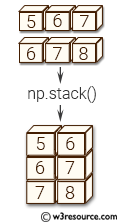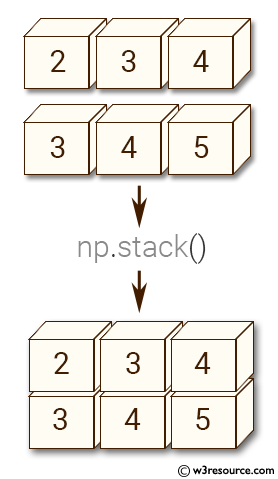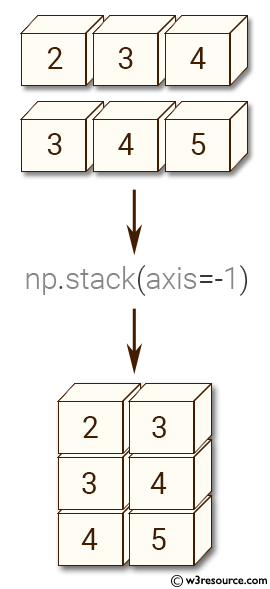NumPy: stack() function
numpy.stack() function
The stack() function is used to join a sequence of arrays along a new axis.
The axis parameter specifies the index of the new axis in the dimensions of the result. For example, if axis=0 it will be the first dimension and if axis=-1 it will be the last dimension.
Syntax:
numpy.stack(arrays, axis=0, out=None)

Version: 1.15.0
Parameter:
| Name | Description | Required / Optional |
|---|---|---|
| arrays | Each array must have the same shape. | Required |
| axis | The axis in the result array along which the input arrays are stacked. | Optional |
| out | If provided, the destination to place the result. The shape must be correct, matching that of what stack would have returned if no out argument were specified. | Optional |
Return value:
stacked : ndarray The stacked array has one more dimension than the input arrays.
Example-1: numpy.stack() function
>>> import numpy as np
>>> arrays = [np.random.randn(2, 3)for _ in range(8)]
>>> np.stack(arrays, axis=0).shape
(8, 2, 3)
Example-2: numpy.stack() function
>>> import numpy as np
>>> np.stack(arrays, axis=1).shape
(2, 8, 3)
>>>
>>> np.stack(arrays, axis=2).shape
(2, 3, 8)
>>>
>>> x = np.array([2, 3, 4])
>>> y = np.array([3, 4, 5])
>>> np.stack((x, y))
array([[2, 3, 4],
[3, 4, 5]])
Pictorial Presentation:

Example-3: numpy.stack() function
>>> import numpy as np
>>> x = np.array([2, 3, 4])
>>> y = np.array([3, 4, 5])
>>> np.stack((x, y))
array([[2, 3, 4],
[3, 4, 5]])
>>> np.stack((x, y), axis=-1)
array([[2, 3],
[3, 4],
[4, 5]])
Pictorial Presentation:

Python - NumPy Code Editor:
Previous: concatenate()
Next: column_stack()
- New Content published on w3resource:
- HTML-CSS Practical: Exercises, Practice, Solution
- Java Regular Expression: Exercises, Practice, Solution
- Scala Programming Exercises, Practice, Solution
- Python Itertools exercises
- Python Numpy exercises
- Python GeoPy Package exercises
- Python Pandas exercises
- Python nltk exercises
- Python BeautifulSoup exercises
- Form Template
- Composer - PHP Package Manager
- PHPUnit - PHP Testing
- Laravel - PHP Framework
- Angular - JavaScript Framework
- Vue - JavaScript Framework
- Jest - JavaScript Testing Framework
